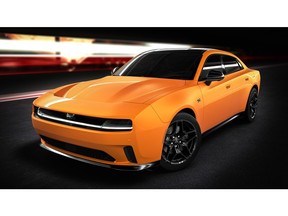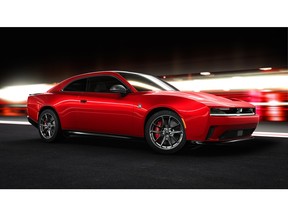
Article content
The new electric Dodge Charger models may qualify as green machines, but Stellantis has leaned heavily into the vehicle’s American muscle car past emphasizing performance while adding some practicality in hopes of broadening its demographic appeal.
On Tuesday Dodge took the wraps of the much-anticipated next generation of muscle cars, which will be produced at Windsor Assembly Plant.
Advertisement 2
Article content
Article content
Full production of the battery electric two-door, 496 horsepower Dodge Charger RT and the 670-horsepower Charger Daytona Scat Pack models will begin this summer, though an actual date has not been set.
All Charger models will also come with standard all-wheel drive and will be the first Stellantis vehicles to use the STLA large platform.
The electric Scat Pack models take 3.3 seconds to go from 0 to 100 km/h and will do a quarter mile in an estimated 11.5 seconds.

“This started 10-12 years ago when we started distilling the brand down to be performance based, an American-muscle brand to be true to that ethos,” said Dodge CEO Tim Kuniskis, who added the price of the new Charger models is still the subject of ‘heated debate internally.’
“At the same time, we knew the storm was coming, we knew the regulations were tightening in around us.
“We knew we needed a dual path both inside and outside. Inside we needed to develop this new technology and outside we needed to sell all the ICE (internal combustion technology).
“We’re going to use electrification to make muscle cars faster and better.”
Advertisement 3
Article content

Kuniskis also confirmed the Challenger nameplate will be put on the shelf for the time being.
The first two models will be followed by a series of launches beginning early next year.

In the first quarter of 2025, Dodge will first introduce the four-door version of the electric Charger, followed by the two- and four-door editions of the gas-powered Charger and six power levels of the electric vehicles.
The gas-powered Charger series will be available in two power levels.
The Charger SIXPACK H.O. will offer 550 horsepower from the 3.0-litre twin turbo Hurricane High Output engine while the 3.0-litre twin turbo Hurricane Standard Output engine will produce 420 horsepower.
The last Charger model to launch at Windsor Assembly in 2025 will be the Charger SRT Banshee, which brings another two power levels. It will have an 800-volt system and though Dodge has not released its horsepower figures, it has promised it will exceed the 6.2-litre V8-powered Charger Hellcat that comes from the factory with 797 horsepower.
The new Chargers also offer a PowerShot button that adds 400 to 80 more horsepower, depending on the model, over 15 seconds.
Advertisement 4
Article content
“This is still the quickest, most powerful muscle car you can buy at launch,” said Kuniskis, who added owners will still be able to personalize their cars with kits as they do now.
“The Scat Pack beats the Hellcat Redeye widebody at 3.3 seconds (0 to 60 mph).”
To offer improved handling, Dodge is offering 305mm front/325mm rear tires with 20-inch wheels along with 16-inch rotors in its regenerative braking system. The extra width of the body also gives the Charger one of the larger presences on the road.
The Daytona RT and Scat Pack will both use 400-volt systems.
The Chargers will carry a lithium-ion battery using a nickel, cobalt and aluminum chemistry. The battery pack delivers 100.5 kW and has a peak discharge rate of 550 kW aimed at maximizing acceleration.
Kuniskis said Dodge opted to forego concerns about efficiency and reduced range to stay true to its muscle car roots. The 800-volt version of the STLA large platform can produce 800 km of range.
The Daytona RT will have a range of over 510 km on single charge while the Scat Pack can cover 418 km.
“People aren’t buying Chargers and Challengers now for good gas mileage,” Kuniskis said. “It’s a 17 million unit per year industry and people need choices.”
Advertisement 5
Article content
Both vehicles can be recharged from a 20 to 80 per cent charge status in just over 27 minutes when using a Level 3 DC CCS fast charger. The rate of charging is approximately 16 kilometres per minute for the Daytona R/T and 13 kilometres for the Daytona Scat Pack, using a 350-kW fast charger.
By offering a variety of trim levels and packing the vehicles with new, connected technology, multiple driving modes, 64-colour attitude adjustment lighting, all new seating, an optional full-length glass roof and changeable dash and cluster displays in a sleek interior, the comfort level of passengers hasn’t been overlooked for the need for speed.
The vehicle’s instrument panel and console feature a free-standing, wide format 10.25-inch or available 16-inch cluster screen, with a 12.3-inch screen for the centre display. The dash display is inspired by the classic 1968 Dodge Charger instrument panel.
“The clean, sculpted design of the exterior, that cleanness has been brought into the interior,” said Ryan Nagode, vice-president- interior design, Stellantis North America.
Advertisement 6
Article content
“We wanted a cockpit feel inside.”
Going electric won’t mean forgoing the sound and feel of the V8 power craved by so many Charger owners.
Dodge has a patent pending on its Fratzonic Chambered Exhaust, which replicates the sound and feel of the Hellcat. The system can also be turned off for a quieter ride.
All versions of the Charger are the same size and there will be eight exterior colour options.
In its quest for power and performance, Dodge didn’t overlook practicality.
The Charger will feature second-row seats that fold flat giving it a rear cargo area of 1,090 litres (38.5 cubic feet). The ‘frunk’ under the hood of the electric Chargers will offer another 42 litres (1.5 ft cubic feet) of storage.
Dwaddell@postmedia.com
Twitter.com/windstarwaddell
Article content



